Chapter 2
Joining
the Varsity
Within a few days of starting my
fire service career, I learned that not all fire departments are
alike. The department I had joined served only about 30,000
people in an area of only 8 square miles. Not much happened
there. Entire shifts would go by without receiving an alarm for
any kind of emergency.
As mentioned, before starting with
the fire department I worked for a private ambulance company in
East LA. It was a sleazy outfit. They paid a dollar an hour with
deductions for mealtime and sleeping. About half the time, the
paychecks bounced. The boss gave me six months to read the Red
Cross Basic First Aid book and pass the test. Meanwhile, he put
me in the back of the ambulance with patients (because he didn't
trust me to drive).
In spite of all the negatives, we
got a lot of calls and every one of them was a learning
experience for me. The fatal Kansas farm accident I wrote about
in "Dalmatian Tales" (www.jems.com) was still fresh in my memory and I was
somehow determined to overcome the apprehension of seeing broken
bodies. I conquered the compulsion to throw up when confronted by
blood or smelly excretions. I learned how to splint broken limbs
and lift patients without hurting them or me. The boss taught me
how to immobilize violent patients. But still, there was so much
we could NOT do.
In 1957, new firefighters were
paid $361 per month. To make a little extra money, I worked at
the ambulance company two or three days a month. The boss even
let me drive an ambulance on occasion.
I passed my probation under
Captain Lawrence and the chief transferred me to station 1
(headquarters) so I could work on the rescue truck. He was aware
of my ambulance experience. The rescue truck got more calls than
station 2 did but the Monterey Park Fire Department wasn't
challenging enough to satisfy my needs. So I applied for the Los
Angeles County Fire Department, which had nearly 100 stations in
all kinds of environments. Then and now, among fire departments
in California, LA County was considered the varsity (and I wanted
to play on the varsity team).
In '59, I was hired by the County
and went through the ten-week recruit training academy. Since
Monterey Park used County training manuals, there were few
surprises for me in recruit training. I was so proud to be part
of that organization. In addition to increased pay ($489 per
month), the Captains and Chiefs in the County Fire Department
seemed supremely confident and cool. Also, it was clear that many
opportunities for challenge and advancement would be available to
me.
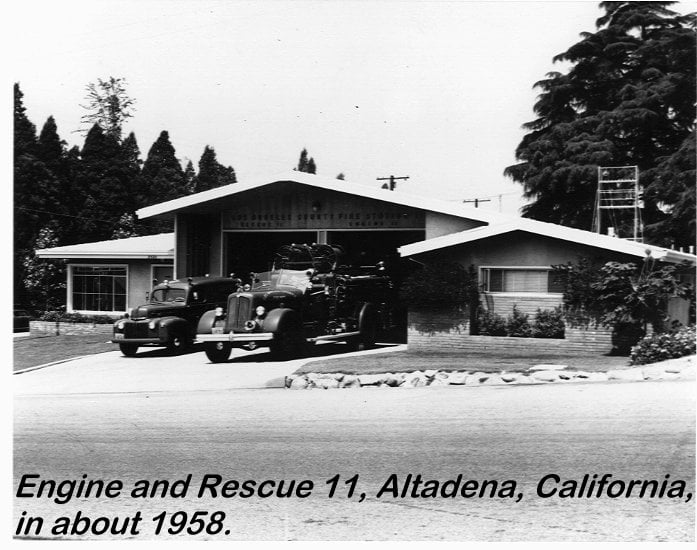 When we got our station assignments, I was
sent to station 11 in Altadena. By this time, I had an Advanced
First Aid card and I was a Red Cross first aid instructor. For
these reasons, Captain Sam Hancock at station 11 assigned me to
the rescue truck.
When we got our station assignments, I was
sent to station 11 in Altadena. By this time, I had an Advanced
First Aid card and I was a Red Cross first aid instructor. For
these reasons, Captain Sam Hancock at station 11 assigned me to
the rescue truck.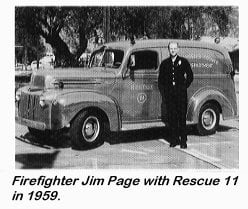
In August '59, I bought my first
home (for $11,000) in the suburbs about 20 miles east of L.A.
Later that year, after a romance of six months, I married Pat, a
divorced single mother (she had a two-year old boy). So, at age
23, I had a good start on my career, I was working on my
education, and had a ready-made family.
Career
Moves
In '61, an inspector vacancy
occurred in the Fire Prevention Bureau in East Los Angeles. That
is a major industrial area and it seemed to me an opportunity to
learn a lot about fire codes, building construction, fire cause
investigation, chemical processes, etc. Even though it meant
working 8-hour days, 40 hours a week (rather than the 24-hour
shift schedule), I applied and was accepted. It became a
wonderful experience that greatly broadened my knowledge and
prepared me for promotional exams. Also in '61, my son Tom was
born and we moved to a larger house in the suburb of West Covina
($16,000).
In '63, I competed in a
promotional exam process for the position of Firefighter
Specialist (Fire Apparatus Engineer). I came out #1 on the list
and was assigned to Truck 8 in West Hollywood, the station that
was used in the World Premiere of "Emergency!"). It was
another great learning experience - being responsible for the
ladder truck in a densely populated area of high-rise buildings.
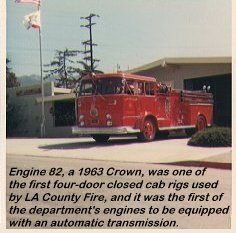 After a year, I decided I wanted some brush
fire experience so I transferred to station 82 in LaCanada.
There, serving as Engineer for Captain Jim Enright, a savvy brush
fire tactician, I drove and pumped my way through two fire
seasons. We responded to brush fires all over the county (our
longest response was 56 miles, one-way). The lessons learned from
Jim served me well in later assignments.
After a year, I decided I wanted some brush
fire experience so I transferred to station 82 in LaCanada.
There, serving as Engineer for Captain Jim Enright, a savvy brush
fire tactician, I drove and pumped my way through two fire
seasons. We responded to brush fires all over the county (our
longest response was 56 miles, one-way). The lessons learned from
Jim served me well in later assignments.
While I was assigned to 82's, my
son Andy was born. Also, during this time, I finished my
undergraduate education and entered law school (attending night
classes and trading time with others to get off duty for school).
In August '65, while I was taking my final exam in criminal law,
the Watts Riots started. As soon as I arrived home, I was
recalled to duty and spent the next 40 hours as the engineer on
Engine 282, running from fire to fire throughout south LA.
Both stations 8 and 82 were big
houses, with multiple rigs (engines and trucks) and 10 to 12
people on duty. Thus, there was always a lot of activity and
plenty of fun and games. To the extent that I could influence the
"feeling" of station 51's environment and personal
interactions (in my early advice to and consultations with
producer Bob Cinader and writers and directors of
"Emergency!"), I tried to transfer the experience I had
had at stations 8, 82, and others.
The
Topanga Chapter
In 1965, the promotional process
for Fire Captain was announced. I applied but, because of the
demands of law school, I had no time to study for the test. When
the list came out, I was #2. All the various experiences, and the
discipline, reading comprehension, and logical reasoning that is
part of college and graduate education made the difference for
me.
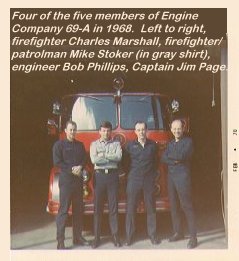 The following April (at age 29), I was
appointed Fire Captain and assigned to station 69 in Topanga
Canyon.
The following April (at age 29), I was
appointed Fire Captain and assigned to station 69 in Topanga
Canyon.
At first I was disappointed. I had
hoped for an assignment to a busy station in South LA. It was a
42-mile drive from West Covina to Topanga. But then it occurred
to me that 69's would be an ideal place to work while finishing
law school. Except for an occasional vehicle crash on serpentine
Topanga Canyon Blvd., there wasn't much action after 6:00pm most
nights. I figured I could get a lot of studying done while on
duty.
In the mountainous areas of LA
County, Fire Captains are expected to patrol their districts and
know the terrain well enough to predict the course and behavior
of brush fires in varying wind conditions. Also, while on patrol,
they are expected to issue citations for illegal burning or
smoking in closed areas, and to encourage residents to clear
brush and other combustibles away from their buildings. In order
to do all this most of the stations have a patrol pick-up truck
in addition to a pumper. Station 69 had two patrol trucks, one
for the Captain (Patrol 69) to use and the other for the
firefighter/patrolman (Patrol 269).
A few weeks after I was promoted,
I was patrolling the area and stumbled onto the Sandstone Ranch.
It was about a half mile off the paved road (Saddle Peak Road)
and had a commanding view of the Pacific Ocean and Catalina
Island.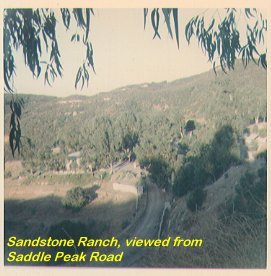 The ranch was about two miles inland from
the coast and about 2,500 feet altitude. As I drove down the dirt
drive, I came into a compound that included a very large ranch
house with panoramic windows, two guesthouses, and an A-frame
building over a 20' x 40' swimming pool. On the hill above the
compound was a barn and corrals.
The ranch was about two miles inland from
the coast and about 2,500 feet altitude. As I drove down the dirt
drive, I came into a compound that included a very large ranch
house with panoramic windows, two guesthouses, and an A-frame
building over a 20' x 40' swimming pool. On the hill above the
compound was a barn and corrals.
An old Volkswagen was in the
carport. Weeds and brush were growing up against the buildings.
Eucalyptus leaves were a foot thick in some spots. The place
would be impossible to save if a brush fire came through. I
knocked on all the doors and could not find anything more than a
couple of lazy cats. So I drove back to the station, looked up
the property records, and learned that the Sandstone Ranch was in
a trusteeship being administered by Security Pacific Bank. I
called the trust officer in charge.
The man apologized profusely for
the condition of the ranch. "We've had a hard time finding a
responsible caretaker for the place," he said. "We can
only offer free rent and $200 a month." He went on to
explain that they were evicting the guy whose VW was in the
carport. I asked if he would consider hiring a local Fire Captain
as caretaker. He jumped at the chance.
My wife had been pretty much alone
raising the kids. Between my career and school and studying, I
wasn't around much (physically or emotionally). I thought she
would be thrilled by the opportunity to live on a ranch in the
mountains near Malibu. At least I would be commuting three miles
to work rather than 42. She went along with it, but then was
confronted by the reality of rattlesnakes sunning themselves on
the driveway, the loneliness of having no nearby neighbors, the
isolation of being ten miles from the nearest store, and the
howling of coyotes in the night.
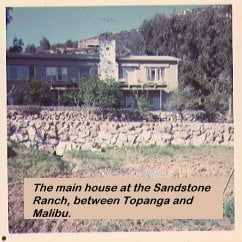 The kids, on the other hand, loved it - and
so did I. I set up one of the guesthouses as my study. I would
take breaks in my studies during the summer months and go
swimming with the kids. We let a lady keep her horses in the barn
and she would let the boys ride them. We got a Great Dane puppy,
and she grew into a beautiful animal that could run free on the
73-acre ranch. I found a farmer who needed a place to park his
tractors and implements. In exchange, he let me use them to keep
the weeds and brush under control on the ranch (as often as not,
I had one of the boys on my lap while I drove a tractor).
The kids, on the other hand, loved it - and
so did I. I set up one of the guesthouses as my study. I would
take breaks in my studies during the summer months and go
swimming with the kids. We let a lady keep her horses in the barn
and she would let the boys ride them. We got a Great Dane puppy,
and she grew into a beautiful animal that could run free on the
73-acre ranch. I found a farmer who needed a place to park his
tractors and implements. In exchange, he let me use them to keep
the weeds and brush under control on the ranch (as often as not,
I had one of the boys on my lap while I drove a tractor).
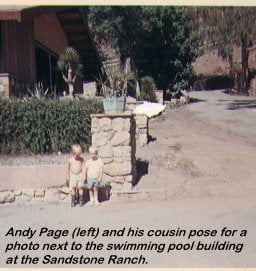 The ranch was for sale the whole time we
lived there, and we had sold our home in West Covina. The boys
knew that we might have to move when the place sold but we had no
place to move to. On one occasion, a realtor called to tell me
he'd be bringing a potential buyer to see the place. He asked if
I'd keep the kids away from his client. When I asked why, he
revealed that my boys frequently would offer to help show the
property and then would entertain the visitors with stories about
rattlesnakes, overflowing septic tanks, coyotes eating our cats,
and the potential for brushfires.
The ranch was for sale the whole time we
lived there, and we had sold our home in West Covina. The boys
knew that we might have to move when the place sold but we had no
place to move to. On one occasion, a realtor called to tell me
he'd be bringing a potential buyer to see the place. He asked if
I'd keep the kids away from his client. When I asked why, he
revealed that my boys frequently would offer to help show the
property and then would entertain the visitors with stories about
rattlesnakes, overflowing septic tanks, coyotes eating our cats,
and the potential for brushfires.
Some of the Topanga experience
snuck into my script for Drivers - the public education scene in
"Tonapah Canyon" and the kid stuck in a tree at the
"Powderhorn Ranch." All good things must come to an
end, and the Sandstone Ranch sold after we'd been there about
2-1/2 years. The couple who bought it gave us 30 days to vacate
the premises. I offered to move my family into one of the
guesthouses and to continue taking care of the place for free.
They wanted us gone as soon as possible. Later, we found out why.
They intended to turn it into a "resort for swingers"
and they didn't want any kids around. Within 30 days, we had
purchased a home in Hacienda Heights and vacated the Sandstone
Ranch.
During the 70's, the Sandstone
became famous (or infamous) and was referred to in Gay Talese's
book, "Thy Neighbor's Wife." I'm always careful to
point out that we lived there BEFORE it became famous (or
infamous). Nonetheless, it was a great experience and the boys -
now married with families of their own - periodically mention
something about "when we lived on the ranch."
Because I was in law school, and
the fire department leadership knew it, they transferred to me at
station 69 a succession of people with severe problems
(alcoholism, psychosis, etc.). Chief "Red" Meagher, the
operations chief, told me he felt I would be able to build a case
that could survive a civil service commission hearing. It was
another learning experience, and I tried to salvage people before
discharging them. Finally, I asked that I not be used as the
department's executioner. It was not fair to the rest of my crew
and it was making it difficult to concentrate on my studies. In a
couple of cases, it was downright dangerous.
Chief Meagher agreed, and the next
vacancy that occurred on my crew was filled with a recruit from
the training tower. His name was Bob McCullough and he later
became one of the most frequently employed technical advisors on
the "Emergency!" series. In 1968, we had another
vacancy and it "went out to bid" (which means it was
made available for anyone with transfer rights to bid on). The
successful bidder was a handsome young firefighter named Mike
Stoker.
Copyright 1998,
James O. Page
CHAPTER 3
 When we got our station assignments, I was
sent to station 11 in Altadena. By this time, I had an Advanced
First Aid card and I was a Red Cross first aid instructor. For
these reasons, Captain Sam Hancock at station 11 assigned me to
the rescue truck.
When we got our station assignments, I was
sent to station 11 in Altadena. By this time, I had an Advanced
First Aid card and I was a Red Cross first aid instructor. For
these reasons, Captain Sam Hancock at station 11 assigned me to
the rescue truck.
 After a year, I decided I wanted some brush
fire experience so I transferred to station 82 in LaCanada.
There, serving as Engineer for Captain Jim Enright, a savvy brush
fire tactician, I drove and pumped my way through two fire
seasons. We responded to brush fires all over the county (our
longest response was 56 miles, one-way). The lessons learned from
Jim served me well in later assignments.
After a year, I decided I wanted some brush
fire experience so I transferred to station 82 in LaCanada.
There, serving as Engineer for Captain Jim Enright, a savvy brush
fire tactician, I drove and pumped my way through two fire
seasons. We responded to brush fires all over the county (our
longest response was 56 miles, one-way). The lessons learned from
Jim served me well in later assignments.  The following April (at age 29), I was
appointed Fire Captain and assigned to station 69 in Topanga
Canyon.
The following April (at age 29), I was
appointed Fire Captain and assigned to station 69 in Topanga
Canyon. The ranch was about two miles inland from
the coast and about 2,500 feet altitude. As I drove down the dirt
drive, I came into a compound that included a very large ranch
house with panoramic windows, two guesthouses, and an A-frame
building over a 20' x 40' swimming pool. On the hill above the
compound was a barn and corrals.
The ranch was about two miles inland from
the coast and about 2,500 feet altitude. As I drove down the dirt
drive, I came into a compound that included a very large ranch
house with panoramic windows, two guesthouses, and an A-frame
building over a 20' x 40' swimming pool. On the hill above the
compound was a barn and corrals. The kids, on the other hand, loved it - and
so did I. I set up one of the guesthouses as my study. I would
take breaks in my studies during the summer months and go
swimming with the kids. We let a lady keep her horses in the barn
and she would let the boys ride them. We got a Great Dane puppy,
and she grew into a beautiful animal that could run free on the
73-acre ranch. I found a farmer who needed a place to park his
tractors and implements. In exchange, he let me use them to keep
the weeds and brush under control on the ranch (as often as not,
I had one of the boys on my lap while I drove a tractor).
The kids, on the other hand, loved it - and
so did I. I set up one of the guesthouses as my study. I would
take breaks in my studies during the summer months and go
swimming with the kids. We let a lady keep her horses in the barn
and she would let the boys ride them. We got a Great Dane puppy,
and she grew into a beautiful animal that could run free on the
73-acre ranch. I found a farmer who needed a place to park his
tractors and implements. In exchange, he let me use them to keep
the weeds and brush under control on the ranch (as often as not,
I had one of the boys on my lap while I drove a tractor). The ranch was for sale the whole time we
lived there, and we had sold our home in West Covina. The boys
knew that we might have to move when the place sold but we had no
place to move to. On one occasion, a realtor called to tell me
he'd be bringing a potential buyer to see the place. He asked if
I'd keep the kids away from his client. When I asked why, he
revealed that my boys frequently would offer to help show the
property and then would entertain the visitors with stories about
rattlesnakes, overflowing septic tanks, coyotes eating our cats,
and the potential for brushfires.
The ranch was for sale the whole time we
lived there, and we had sold our home in West Covina. The boys
knew that we might have to move when the place sold but we had no
place to move to. On one occasion, a realtor called to tell me
he'd be bringing a potential buyer to see the place. He asked if
I'd keep the kids away from his client. When I asked why, he
revealed that my boys frequently would offer to help show the
property and then would entertain the visitors with stories about
rattlesnakes, overflowing septic tanks, coyotes eating our cats,
and the potential for brushfires.